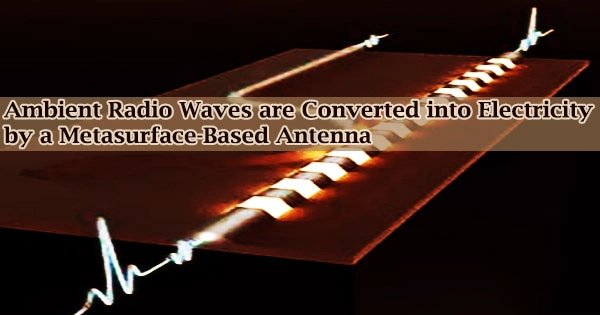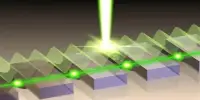In order to make energy harvesting from radio waves, such as those used in Bluetooth links or cell phone networks, practicable, researchers have created a new metasurface-based antenna. It is possible that this technology may allow sensors, LEDs, and other low-power devices to operate wirelessly.
“By eliminating wired connections and batteries, these antennas could help reduce costs, improve reliability and make some electrical systems more efficient,” said research team leader Jiangfeng Zhou from the University of South Florida.
“This would be useful for powering smart home sensors such as those used for temperature, lighting and motion or sensors used to monitor the structure of buildings or bridges, where replacing a battery might be difficult or impossible.”
The researchers write in the journal Optical Materials Express that laboratory tests of their new antenna revealed that it can extract 100 microwatts of electricity from low power radio waves, sufficient to power basic equipment.
This was made possible by the antenna’s usage of metamaterial, which exhibits perfect radio wave absorption and was made to function at low intensities.
“Although more work is needed to miniaturize the antenna, our device crosses a key threshold of 100 microwatts of harvested power with high efficiency using ambient power levels found in the real world,” said Clayton Fowler, the team member who fabricated the sample and performed the measurements. “The technology could also be adapted so that a radio wave source could be provided to power or charge devices around a room.”
With the huge explosion in radio wave-based technologies, there will be a lot of waste electromagnetic emissions that could be collected. This, combined with advancements in metamaterials, has created a ripe environment for new devices and applications that could benefit from collecting this waste energy and putting it to use.
Jiangfeng Zhou
Harvesting energy from the air
For a long time, scientists have attempted to harness the energy of radio waves, but it has been challenging to do so with sufficient energy. This is changing as a result of the advancement of metamaterials and the expansion of ambient radio frequency energy sources, including Wi-Fi, Bluetooth, GPS, and cell phone networks.
“With the huge explosion in radio wave-based technologies, there will be a lot of waste electromagnetic emissions that could be collected,” said Zhou. “This, combined with advancements in metamaterials, has created a ripe environment for new devices and applications that could benefit from collecting this waste energy and putting it to use.”
Metamaterials interact with light and radio waves in ways that naturally occurring materials do not by using tiny, precisely crafted structures.
The energy-harvesting antenna was created by the researchers using a metamaterial that has a high radio wave absorption capacity and permits a larger voltage to traverse the diode of the device. This increased its ability to convert radio waves into power more effectively, especially at low intensity.
Testing with ambient power levels
The researchers assessed the quantity of electricity gathered while varying the power and frequency of a radio source between 0.7 and 2.0 GHz during lab tests of the 16 cm by 16 cm gadget.
They successfully showed that radio waves with an intensity of only 0.4 microwatts per centimeter squared, or roughly the intensity of radio waves at a distance of 100 meters from a cell phone tower, may be used to generate 100 microwatts of power.
“We also placed a cell phone very close to the antenna during a phone call, and it captured enough energy to power an LED during the call,” said Zhou. “Although it would be more practical to harvest energy from cell phone towers, this demonstrated the power capturing abilities of the antenna.”
The researchers are aiming to make the antenna smaller because it is currently far larger than the majority of the devices it may potentially power. In order to acquire more energy, they would also like to create a version that could simultaneously collect energy from other radio wave types.
















